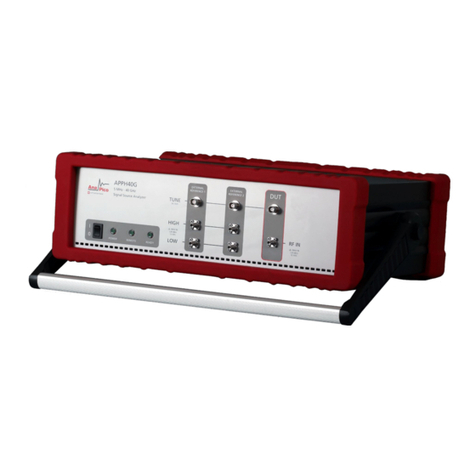
Anapico AG Europastr. 9 CH-8152 Glattbrugg Switzerland Tel: +41 44 515 5501 www..anapico.com
Table of Contents
TABLE OF CONTENTS................................................................................................................................ 3
1INTRODUCTION TO THE APPH ................................................................................................................. 5
1.1 GENERAL FEATURES AND FUNCTIONS ................................................................................................................ 5
1.2 OPTIONS...................................................................................................................................................... 5
1.3 FRONT PANEL OVERVIEW ................................................................................................................................ 6
1.4 REAR PANEL CONNECTIONS ............................................................................................................................. 8
2GETTING STARTED................................................................................................................................. 10
2.1 SYSTEM REQUIREMENTS................................................................................................................................ 10
2.2 UNPACKING THE APPH ................................................................................................................................ 10
2.3 INITIAL INSPECTION ...................................................................................................................................... 10
2.4 STARTING THE APPH ................................................................................................................................... 10
2.4.1 Applying Power ............................................................................................................................. 10
2.4.2 Connecting to LAN via DHCP Router.............................................................................................. 10
2.4.3 Connecting via LAN without DHCP Router (fallback or fixed IP).................................................... 11
2.4.4 Connecting through USB to APPH GUI .......................................................................................... 11
2.4.5 Connecting through USBTMC & VISA ............................................................................................ 11
2.4.6 Connecting through GPIB & VISA .................................................................................................. 12
2.4.7 Using Anapico Application Programming Interface (API).............................................................. 12
2.4.8 Installing the APPH Graphical User Interface Software................................................................. 12
2.4.9 Troubleshooting ............................................................................................................................ 12
2.4.10 Shutting Down the APPH .......................................................................................................... 13
2.4.11 Perform Firmware Upgrade...................................................................................................... 13
2.4.12 Serial Number ........................................................................................................................... 13
3MEASUREMENT USING THE GRAPHICAL USER INTERFACE (GUI) ........................................................... 14
3.1 START THE APPH GUI.................................................................................................................................. 14
3.2 ORGANIZATION OF THE GUI .......................................................................................................................... 15
3.2.1 Menu Section................................................................................................................................. 15
3.3 MEASUREMENT TABS ................................................................................................................................... 21
3.3.1 General Tab Organization ............................................................................................................. 21
3.4 PHASE NOISE MEASUREMENT TAB.................................................................................................................. 22
3.4.1 Measurement setup ...................................................................................................................... 22
3.4.2 Using External References ............................................................................................................. 26
3.4.3 The Different Plot Window Tabs.................................................................................................... 27
3.4.4 The Traces Window ....................................................................................................................... 29
3.4.5 The Marker Window...................................................................................................................... 32
3.4.6 Inside Plot Window Functions ....................................................................................................... 33
3.4.7 Saving Traces................................................................................................................................. 34
3.4.8 Oversampling factor (APPH6000 / APPH30G only) ....................................................................... 34
3.5 GENERAL MEASUREMENT SETTINGS ................................................................................................................ 36
3.5.1 Number of data points per trace ................................................................................................... 36
3.5.2 Measurement time (using GUI) ..................................................................................................... 36
3.6 AM NOISE MEASUREMENT (APPH6000 ONLY) ............................................................................................... 38
3.7 ADDITIVE PHASE NOISE MEASUREMENT........................................................................................................... 39
3.7.1 Measurement Procedure............................................................................................................... 39
3.8 TRANSIENT ANALYZER MEASUREMENT ............................................................................................................ 43
3.9 FFT ANALYZER MEASUREMENT...................................................................................................................... 44
4SYSTEM CALIBRATION (FIRMWARE 1.0 AND UP)................................................................................... 45
5REMOTE PROGRAMMING THE APPH..................................................................................................... 47




























